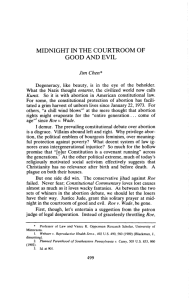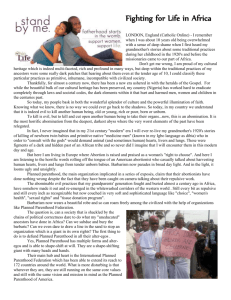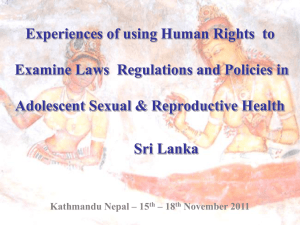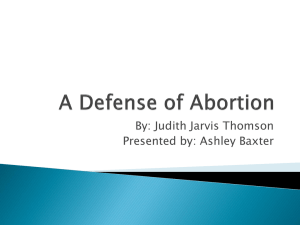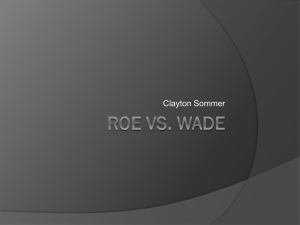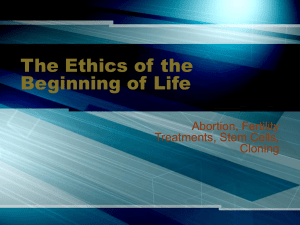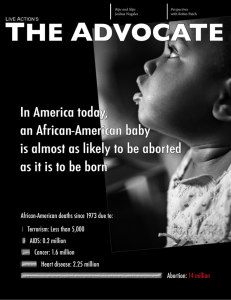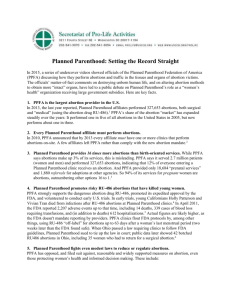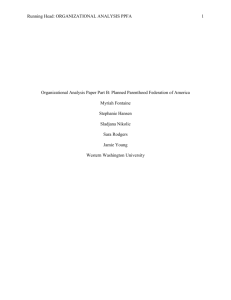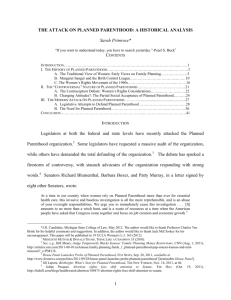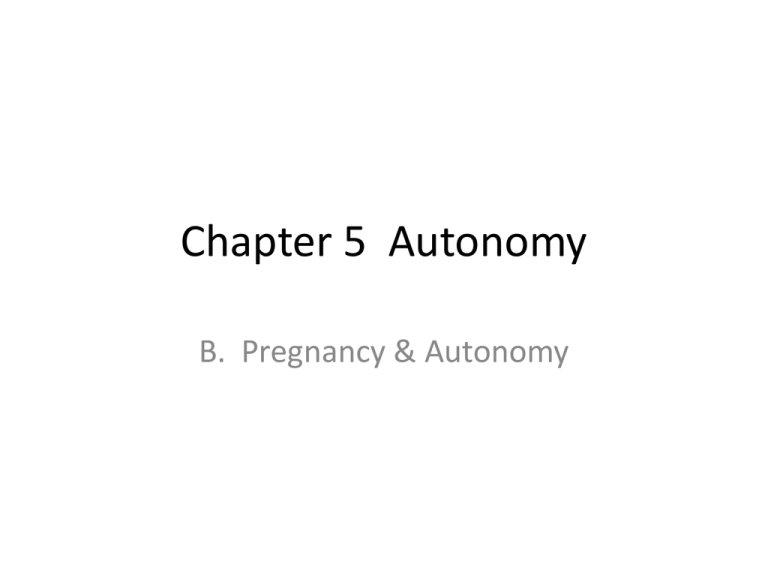
Chapter 5 Autonomy
B. Pregnancy & Autonomy
1. Control of Conception & Other
Aspects of Women’s Health
pp. 500-506
• Control over reproductive destiny: central
to autonomy, equality, non-subordination
• Griswold v. Conn. (‘65)(married couples’
right of privacy to use contraceptives)
• Eisenstadt v. Baird (‘72)(extended
Griswold to unmarried persons)
• Roe v. Wade (‘73)(abortion)
1. Control of Conception & Other
Aspects of Women’s Health
pp. 500-506
Griswold v. Conn. (‘65)(7-2)
·statute criminalized use of contraceptives by
married couples; medical providers convicted as
accessories to crime, had standing to assert
patients’ privacy rights.
·Douglas, for maj.: Found penumbral “zones of
privacy” from 1st (rt of ass’n), 3d (no peacetime
quartering of soldiers), 4th, 5th, 9th (rts retained
by people), 14th Am. D.P. Clause.
Griswold v. Conn., Douglas for Maj.
• Right of privacy in marriage
– Ancient institution, precedes Bill of Rights,
Constitutional Convention
– Intimate to degree of being sacred
– Promotes way of life, harmony, bilateral loyalty
– Association as noble a purpose as any prior dcn
• Statute forbade USE; maximum destructive
impact on relationship
• Govt’l purpose to control/prevent m/n be
achieved by overbroad means that invade
protected freedoms
Griswold v. Conn., Goldberg,
Warren,Brennan concurrence
• Narrower grounds: marital right of privacy as
fundamental, personal right “retained by the
people” under 9th Am.
• D/n interfere w/ State’s proper regulation of
sexual promiscuity or misconduct
– Quoting Harlan, State may not regulate through
criminal law details of marital intimacy.
2. Contraception & Women’s
Autonomy
• Clicker: Do women benefit from being ones
primarily responsible for birth control? (yes, no,
uncertain/debatable)
• Preventing conception by sexually active women
–
–
–
–
–
19% birth control pills
17% condoms
17% female sterilization
6% male sterilization
4% injectable contraceptives, diaphragms, IUDs, other
Plan B: Contraception
“Morning After Pill”
·Used when condom fails, or otherwise has
unprotected sex. Not generally re promiscuity.
·Available without prescription to consumers 17
years or older. Reqts for pharmacy access vary
among states. Okla.?
·Prevents ovulation, may prevent fertilization, alters
endometrium (may inhibit implantation)
“What would you do”?
http://www.youtube.com/watch?v=XPWsLAEujmI
3. Gender Bias in Health Care
p. 504
• Long history: excluded from medical research & drug
test trials. NIH Revitalization Act 1993.
• Sexuality/gendered medical product disasters: Dalkon
Shield IUD (unbearable pain, perforation, infection,
sterility); DES – to prevent miscarriages (cancer, birth
defects, male sterility); Benedictin – anti-nausea (birth
defects), silicone breast implants (leakage > arthritic,
autoimmune disorders)
• Differential health care treatment: gender, race,
ethnicity, class (heart attack symptoms, psychological
disorders)
4. Insurance & Women’s Health
pp. 504-05
• EEOC v. UPS (D. Minn. 2001)(employer’s
selective exclusion of prescription
contraceptives from comprehensive
prescription plan violated Title VII)
• “Since late 1990s, fed. Govt & growing
number of states require health plans to
include prescription contraceptives if other
prescription drugs are covered.” fn 167: 2004
art., listed 20 states]
4. Insurance & Women’s Health
• Health Care Reform Act & pending regulations:
Nov. 2011-Feb. 2012 bruhaha, re whether
Catholic employers must provide contraception
coverage. Q: is this “war on religion”?
• “Obama compromise” places requirement to
provide birth control on insurance company &
not employer.
• Q: what is appropriate resolution? Many
“Catholic” employers have millions of nonCatholic employees.
5. Sterilization
p. 505
• Ugly history
– Buck v. Bell (1927) OWH “3 generations of imbeciles is enough”;
upheld forced sterilization.
– Skinner v. Oklahoma (1942)(invalidating forced vasectomy of
habitual felony offenders)
– N.C. forced sterilization of welfare moms. Cf. In re Primus
(1975)(pro bono volunteer lawyer’s offer to represent protected
1st Am. Core Right of Ass’n)
• Current news: NC developing compensation system for surviving
women who were sterilized under that program.
• Current: ct-authorized sterilization when sought parents &
guardians of developmentally disabled women, if in their
“best interests” (allow sexual activity but avoid pregnancy,
birth of children unable to care for)
2. Abortion
pp. 506-18
• Roe v. Wade (Jan. 22, 1973) N.B. 8 years after
Griswold, 1 year after Eisenstadt; expansion of
penumbral rights. Trimester approach:
– 1st: unfettered; personal decision between woman &
physician
– 2d: State’s compelling interest; may regulate to extent
reasonably related to preservation & protection of
maternal health (provider & facility qualifications,
etc.)
– 3d (?), State’s compelling interest at point of viability,
may ban except when necessary to preserve mother’s
life or health
Pro-life Red Rose
Annual commemorations, protests, calls
for reversing Roe v. Wade
The New Biology & the Question of
Personhood: Implications for Abortion
T.H. Milby, Ph.D., B. D. Perkins,
9 AM. J. LAW & MED. 31 (1983)(discussing cloning,
chimerism & parthenogesis as relevant to defining
beginning of life, personhood).
Cerebral development of the fetus more precise
criterion than viability standard of Roe, which will
be subject to recurrent challenge & reinterpretation
based on improvements in neo-natal medicine.
Cerebral development is more reasonable basis for
regulation, for legal & embryological precision.
Planned Parenthood of Southeastern
PA. v. Casey (1992)
pp. 510-17
1. 24 hour waiting period after medical provider
informs woman (nature of procedure, health
risks of abortion & childbirth, “probable
gestational age of unborn child”) Woman must
sign certification that state published materials
made available.
2. Spousal notification, with exceptions
3. Parental consent for un-emancipated minors
unless medical emergency or judicial by-pass
(mature & IC or “best interests”)
p. 514
Planned Parenthood of Southeastern
PA. v. Casey (1992)
pp. 510-17
O’Connor, Kennedy & Souter, for majority
(forged consensus)
“Liberty finds no refuge in a jurisprudence of
doubt. . . [put aside prior reservations] force of
stare decisis. . .
Reaffirms Roe’s essential holding, p. 510
Planned Parenthood of Southeastern
PA. v. Casey (1992)
pp. 510-17
“Only where state regulation imposes an undue
burden on a woman’s ability [to procure an
abortion] does the power of the State reach into
the heart of the liberty protected by the Due
Process Clause. . . .undue burden is [shorthand for]
conclusion that a state regulation has the purpose
or effect of placing a substantial obstacle in the
path of a woman seeking an abortion of a nonviable
fetus . . . [invalid purpose calculated to inform, not
hinder free choice]” at 512
Planned Parenthood of Southeastern
PA. v. Casey (1992) V. Application
pp. 512-17
¶ 1: Oklahoma statutes parallel
¶ 2: overrules prior cases striking state
requirements to give truthful, nonmisleading
information; psychological well-being is
important facet of health, most women would
find relevant, m/b dispositive impact on fetus –
reduce risk that may later regret uninformed
decision w/ devastating psychological
consequences.
Planned Parenthood of Southeastern
PA. v. Casey (1992) V. Application
pp. 512-17
¶¶4-6 in theory, 24 hr waiting period reasonable
measure, balancing interests …. But closer question,
in practice may be substantial obstacle …. D. Ct. Fact
finding: 2 visits to Dr., exposed to possible
harassment, particularly burdensome to those who
must travel long distances, must explain
whereabouts to husbands, employers, etc. May fall
harder on low income.
While troubling, d/n establish undue burden.
Planned Parenthood of Southeastern
PA. v. Casey (1992) V. Application
pp. 512-17
Spousal consent: detailed D. Ct. fact-findings
(domestic violence, justifiable fears of telling
husband, narrow exceptions virtually non-existent;
lack of certificate > draconian Dr.’s license revoked)
Held, substantial obstacle, likely to prevent many
women from obtaining abortion, same as if it were
banned across the board.
Parental notification upheld, hope minors would
benefit from such consultation. N.B. imptce of
judicial by-pass (incest, rape). Cf. Precious
2. Abortion
http://www.youtube.com/watch?v=3X4_p3yAC8


